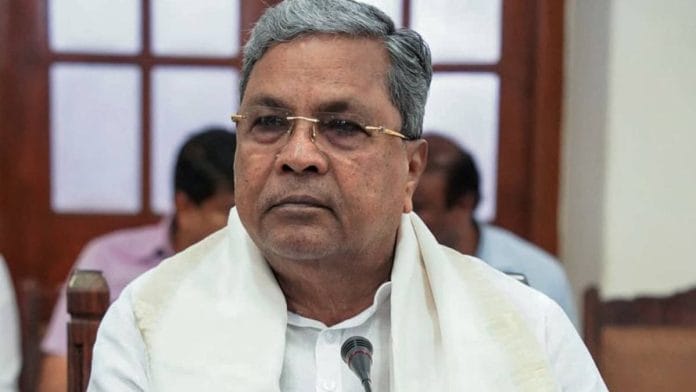Bengaluru: A steady decline in its revenue streams, drying up capital inflows from the Centre, and pressures to fund big-ticket welfare schemes, such as the five guarantees of the Siddaramaiah-led state government, are likely to keep Karnataka from deviating from its practice of excessive reliance on borrowings, data has suggested.
Karnataka’s medium-term fiscal plan (MTFP) has revealed that the borrowings in the last two years have increased the total outstanding liabilities as a percentage of the Gross State Domestic Product (GSDP) by an entire percentage point, from the budget estimate of 23.97 percent in 2022-23 to 24.91 percent in 2025-26.
The MTFP has also projected the state’s total liabilities at Rs 7.65 lakh crore by the end of 2025-26, expected to increase to Rs 10.18 lakh crore by 2028-29. According to senior government officials, most state taxes, such as commercial tax, excise, and stamps and registration, will likely fall short of set targets this fiscal.
To bridge the gap between revenue and development goals, the state will borrow an estimated Rs 1.16 lakh crore this year against Rs 1.05 lakh crore last year, Karnataka Chief Minister Siddaramaiah said in his budget speech Friday.
“In the last two years, we have been falling short by Rs 10,000-12,000 crore,” said a senior Karnataka government official.
The MTFP has also shown that Karnataka’s public debt, including open market borrowing, loans from LIC, NABARD and others, and the Government of India, will jump from the revised estimate of Rs 5.16 lakh crore in 2024-25 to Rs 6.06 lakh crore in 2025-26.
Karnataka, among other southern states, is fighting the Centre to get a fair share of central taxes and cut down on its borrowings.
Also Read: Cash-strapped Karnataka govt considers reviving plan to develop satellite towns around Bengaluru
Shortfall in revenue
In his 16th budget speech Friday, Siddaramaiah said that the Union government’s “failure to fully compensate” for GST revenue loss, non-devolution of cesses and surcharges, and lower tax devolution in the 15th finance commission has “compounded the state’s fiscal challenges”.
Siddaramaiah added that Karnataka has proposed that the share between the Centre and the state be at least 50% of the divisible pool. According to government data, for every rupee Karnataka sends to the Centre now, the state gets only 13 paise back.
A higher share in central taxes will help the state offset the decline in its revenues.
Karnataka has nearly 11 taxes, including commercial tax, stamps & registration, excise and others, to shore up revenues. However, the data has shown that the departments have fallen short of their targets.
In 2024-25, Siddaramaiah set an ambitious target of Rs 38,525 crore for the excise department—one of the state’s more consistent avenues of revenue. During the COVID-19 lockdown, Karnataka was among the first states to open liquor outlets to bring in much-needed money as funds from the Centre dried up.
However, duties from excise have come down by nearly Rs 2,000 crore this time.
According to the state government, the state managed to collect only Rs 36,500 crore this time, nearly Rs 2,000 crore short of its 2024-25 target of Rs 38,525 crore.
“We are falling short of our targets this time. Andhra Pradesh has changed their policy and started tightening the border along Karnataka since our state has the lowest liquor prices in South India, barring Goa,” said the official quoted above.
Similarly, revenue collections in 2024-25 stood at Rs 1.05 lakh crore against the target of Rs 1.1 lakh crore, whereas the shortfall in stamps & registration is over Rs 2,000 crore.
Speaking to ThePrint, at least two government officials said it was a “matter of grave concern” that Karnataka’s income sources were not growing in line with its targets.
To make matters worse, the higher borrowings due to lower incomes have also led to higher interest payments.
The MTFP projected that interest payments will increase from the budget estimate of Rs 36,634 crore in 2025-26 to Rs 67,543 crore in 2028-29.
The interest payments alone are higher than the budgets of several departments together.
‘Guarantee versus development’
The Karnataka chief minister has been under pressure from his party MLAs for not providing funds for development since the Congress government came to power in May 2023. However, Siddaramaiah made a startling claim—he, on average, has given Rs 232 crore per constituency in the state to fulfil his guarantees. He divided the total expenditure of guarantees—roughly Rs 52,000 crore—by 224 constituencies to arrive at the figure.
Economists said that Siddaramaiah’s economy has become a ‘guarantee versus development’ model that provides no alternative vision for growth.
A former faculty member at the National Law School and economist, Abdul Aziz, said that Karnataka’s borrowings were not as alarming as the Centre’s or its peers. However, he added that if Karnataka continued to borrow money, it might reach a point adding to the inflationary pressures.
As of January this year, Karnataka’s inflation stood at 5.03 percent—higher than the national average of 4.31 percent—“reflecting regional price pressure despite economic stability”, according to the MTFP.
Aziz said that if the money borrowed gets invested in increasing the production of goods & services, the inflationary pressures are muted or controlled.
“But what happens is, much of the guaranteed money gets spent on consumption, and demand for goods and services goes up. And the prices are also likely to rise. The savings from guarantees will amount to some goods if the poor invest it, but that does not happen,” Aziz said.
The Karnataka government is trying to rationalise expenditure on its five guarantees and brought the figure down by roughly Rs 1,000 crore, from the budget estimate of Rs 52,009.4 crore in 2024-25 to Rs 51,031 crore for the upcoming fiscal, achieved by removing ineligible people as beneficiaries to schemes such as Gruha Lakshmi and Anna Bhagya.
(Edited by Madhurita Goswami)
Also Read: How Greater Bengaluru panel’s report could clear decks for Shivakumar’s big-ticket pet projects






